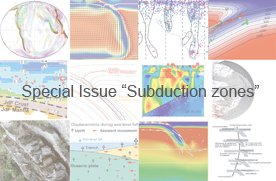Dynamics of interplate domain in subduction zones: influence of rheological parameters and subducting plate age
Abstract. The properties of the subduction interplate domain are likely to affect not only the seismogenic potential of the subduction area but also the overall subduction process, as it influences its viability. Numerical simulations are performed to model the long-term equilibrium state of the subduction interplate when the diving lithosphere interacts with both the overriding plate and the surrounding convective mantle. The thermomechanical model combines a non-Newtonian viscous rheology and a pseudo-brittle rheology. Rock strength here depends on depth, temperature and stress, for both oceanic crust and mantle rocks. I study the evolution through time of, on one hand, the brittle-ductile transition (BDT) depth, zBDT, and, on the other hand, of the kinematic decoupling depth, zdec, simulated along the subduction interplate. The results show that both a high friction and a low ductile strength at the asthenospheric wedge tip shallow zBDT. The influence of the weak material activation energy is of second order but not negligible. zBDT becomes dependent on the ductile strength increase with depth (activation volume) if the BDT occurs at the interplate decoupling depth. Regarding the interplate decoupling depth, it is shallowed (1) significantly if mantle viscosity at asthenospheric wedge tip is low, (2) if the difference in mantle and interplate activation energy is weak, and (3) if the activation volume is increased. Very low friction coefficients and/or low asthenospheric viscosities promote zBDT = zdec. I then present how the subducting lithosphere age affects the brittle-ductile transition depth and the kinematic decoupling depth in this model. Simulations show that a rheological model in which the respective activation energies of mantle and interplate material are too close hinders the mechanical decoupling at the down-dip extent of the interplate, and eventually jams the subduction process during incipient subduction of a young (20-Myr-old) and soft lithosphere under a thick upper plate. Finally, both the BDT depth and the decoupling depth are a function of the subducting plate age, but are not influenced in the same fashion: cool and old subducting plates deepen the BDT but shallow the interplate decoupling depth. Even if BDT and kinematic decoupling are intrinsically related to different mechanisms of deformation, this work shows that they are able to interact closely. Comparison between modelling results and observations suggests a minimum friction coefficient of 0.045 for the interplate plane, even 0.069 in some cases, to model realistic BDT depths. The modelled zdec is a bit deeper than suggested by geophysical observations. Eventually, the better way to improve the adjustment to observations may rely on a moderate to strong asthenosphere viscosity reduction in the metasomatised mantle wedge.






